DAVID GILBERT
SCULPTOR
About the Work
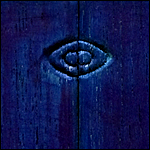
To enter the workshop where many of the sculptures made by David Gilbert are presently housed is to be given at once a lasting impression of a body of work which spans more than five decades and which has at its heart a set of questions and concerns which are sustained and explored unstintingly in space and across time. There is a warmth in the place and a receptiveness. This may be because most of the work is carved in wood which is a more vulnerable and intimate material than bronze or stone or steel. More likely it comes from the fact that the intention behind these concerns is self aware and the approach is humane, workman-like and unpretentious.
Walking Around and Between
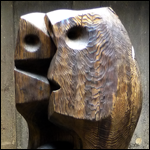 To list the questions, elaborate the concerns, may be unnecessary here but it is worth remembering something novelist Nicholas Mosley wrote (for the catalogue for a one-man show in 1988) about a single piece (March 10th, in private collection) but which could be applied to the whole of this work: ”It is as if what are being shown are the mysteries, the paradoxes (of human love); but also the suggestion that life, like this sculpture, can be apprehended truly as a whole if it is not considered from just one point of view but is walked around, given time, given space as it were. Truth, that is, does not reside in either this observation or that, but in what is intimated, accepted, around and between.”
To list the questions, elaborate the concerns, may be unnecessary here but it is worth remembering something novelist Nicholas Mosley wrote (for the catalogue for a one-man show in 1988) about a single piece (March 10th, in private collection) but which could be applied to the whole of this work: ”It is as if what are being shown are the mysteries, the paradoxes (of human love); but also the suggestion that life, like this sculpture, can be apprehended truly as a whole if it is not considered from just one point of view but is walked around, given time, given space as it were. Truth, that is, does not reside in either this observation or that, but in what is intimated, accepted, around and between.”
Ladders, Balls and Boxes

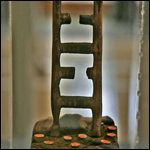 Go round the workshop and it is soon clear that there are a number of recurring forms and themes. Ladders and balls, bowls and cubes reappear many times. The way these forms are included in the sculptures begin to suggest some of the themes. The ladder (appearing most numerously in a piece based on Samuel Beckett’s “The Lost Ones”) intimating hope, escape, impossible longing, endless return. The balls, whatever their size, seeming to take their place as reminders of the universal, of meaning, significance beyond our knowing or saying. The balls sometimes become bowls – smaller or larger hollows carved into them – giving a sense of receptivity, waiting, witnessing. Or deeper bowls of varying sizes, often containing groups of balls – as if reservoirs, stores of meaning. The cubes and boxes are harder to read. Sometimes they become heads, sometimes appear to hold secrets, provide a niche for other forms.
Go round the workshop and it is soon clear that there are a number of recurring forms and themes. Ladders and balls, bowls and cubes reappear many times. The way these forms are included in the sculptures begin to suggest some of the themes. The ladder (appearing most numerously in a piece based on Samuel Beckett’s “The Lost Ones”) intimating hope, escape, impossible longing, endless return. The balls, whatever their size, seeming to take their place as reminders of the universal, of meaning, significance beyond our knowing or saying. The balls sometimes become bowls – smaller or larger hollows carved into them – giving a sense of receptivity, waiting, witnessing. Or deeper bowls of varying sizes, often containing groups of balls – as if reservoirs, stores of meaning. The cubes and boxes are harder to read. Sometimes they become heads, sometimes appear to hold secrets, provide a niche for other forms.Look!

And the themes: the precariousness of our lives together, the burden and struggle of it, the erotic power, the sensuousness, the balance and effort required to stay with the task in hand, and the order and beauty which can wake us to the whole. Each of us will find different ways to describe them and speaking them is not the most important response to be made to this work. More important is the sense painter Howard Hodgkin has articulated with regard to his love of Indian painting. In it, he says “I have found much that for me could not be found anywhere else, but I cannot tell you what – I can only metaphorically wave my arms around at the pictures and say look!”
Images of Man
 The earliest works, from the 1960s, were mostly figurative forms arising out of trying to make images which speak of our lives as we live them now, both personally and collectively. One of these earlier pieces, still in DG’s collection, is “Manpiece 1” - one of a series of three Manpiece sculptures from the mid-60s. DG has described them as arising from the problem of “how to make an image of Man at this point in the history of sculpture”. It is a beautifully carved figure in greenheart, based on the Greek kouros, which emerges from the block and sometimes cleaves back into the raw wood. It renders the incoherent and disintegrated realities of twentieth century western human culture and psychology through the combining of a classically conceived head and one arm with other parts of the same figure showing deformity, disjunction and dehumanisation. It is a remarkable achievement to have realised in a single figure a portrayal of the fragmentation of our reality while at the same time compelling us to look at it.
The earliest works, from the 1960s, were mostly figurative forms arising out of trying to make images which speak of our lives as we live them now, both personally and collectively. One of these earlier pieces, still in DG’s collection, is “Manpiece 1” - one of a series of three Manpiece sculptures from the mid-60s. DG has described them as arising from the problem of “how to make an image of Man at this point in the history of sculpture”. It is a beautifully carved figure in greenheart, based on the Greek kouros, which emerges from the block and sometimes cleaves back into the raw wood. It renders the incoherent and disintegrated realities of twentieth century western human culture and psychology through the combining of a classically conceived head and one arm with other parts of the same figure showing deformity, disjunction and dehumanisation. It is a remarkable achievement to have realised in a single figure a portrayal of the fragmentation of our reality while at the same time compelling us to look at it.The Large Ball
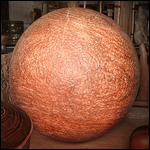 The wooden balls – including the extraordinary “Large Ball” (125cms in diameter, weighing nearly a ton), made in 1974/5 – first emerged after a period of depression in the 1960s, when it became difficult to see what could be worth carving. In the abiding questioning of the purpose of art – including whether it had one and, if so, for whom – DG found this form to be one which enabled him to make a piece which had universal resonance. Many smaller and medium sized wooden balls were and continue to be made, in a variety of different woods, each having their own qualities. Some have become incorporated into composite pieces, some bought into private collections, or given as ‘house balls’ to family members and friends, all carrying an ineluctable presence with them. The “Large Ball” is extraordinary not only for its size and the complex requirements of its carving from the base of an Iroko log imported into Liverpool from West Africa, but because on this scale its bearing is of a different order – impersonal, global, mysterious. Later, DG learned of the huge man-made stone balls found in Puerto Rico, which no-one seemed to know the purpose of and felt that, like his own wooden balls, they carried a meaning understood by everyone.
The wooden balls – including the extraordinary “Large Ball” (125cms in diameter, weighing nearly a ton), made in 1974/5 – first emerged after a period of depression in the 1960s, when it became difficult to see what could be worth carving. In the abiding questioning of the purpose of art – including whether it had one and, if so, for whom – DG found this form to be one which enabled him to make a piece which had universal resonance. Many smaller and medium sized wooden balls were and continue to be made, in a variety of different woods, each having their own qualities. Some have become incorporated into composite pieces, some bought into private collections, or given as ‘house balls’ to family members and friends, all carrying an ineluctable presence with them. The “Large Ball” is extraordinary not only for its size and the complex requirements of its carving from the base of an Iroko log imported into Liverpool from West Africa, but because on this scale its bearing is of a different order – impersonal, global, mysterious. Later, DG learned of the huge man-made stone balls found in Puerto Rico, which no-one seemed to know the purpose of and felt that, like his own wooden balls, they carried a meaning understood by everyone.
 During the later 1970s and early 1980s DG began to find limitations in the making of single figurative forms able to contain the complex meanings he was wanting to convey. He started to assemble and group together some of the smaller pieces in different combinations and contexts, and began to arrive at a process of carving and placing together a series of collections of pieces called “In The Presence Of”. One of the most mysterious of these composite pieces, “In The Presence Of (Head)”, has a slender figure striding past a strange elongated head, its form having echoes of the ancient roots of the Indian subcontinent. The figure is set on a path etched with circles it seems to be stepping within. On one of the sections of path behind the figure, a small ball is placed within the circle; in the section behind that, the circle is empty. On the marble base, laid before the head, is a torso-like form, and beyond it, another ball. This is a piece which becomes more ineffable, the more one looks, with movement and stillness, action and contemplation all in one concentrated place.
During the later 1970s and early 1980s DG began to find limitations in the making of single figurative forms able to contain the complex meanings he was wanting to convey. He started to assemble and group together some of the smaller pieces in different combinations and contexts, and began to arrive at a process of carving and placing together a series of collections of pieces called “In The Presence Of”. One of the most mysterious of these composite pieces, “In The Presence Of (Head)”, has a slender figure striding past a strange elongated head, its form having echoes of the ancient roots of the Indian subcontinent. The figure is set on a path etched with circles it seems to be stepping within. On one of the sections of path behind the figure, a small ball is placed within the circle; in the section behind that, the circle is empty. On the marble base, laid before the head, is a torso-like form, and beyond it, another ball. This is a piece which becomes more ineffable, the more one looks, with movement and stillness, action and contemplation all in one concentrated place.
Bearing the Burden
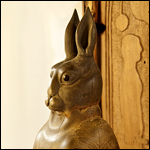 The culmination of these composite pieces was the large group “In The Presence Of (Mountain Hares)”, (1982-84). Made during the period of living with his family on the Isle of Man (1971 to 1988), from mostly local materials, the original impulse arose from watching and drawing mountain hares – “wonderful creatures alert with dignity and self-containment in their lone lives on the moors” - through the seasons. After being given a dead mountain hare, drawings were made from it over three days, which led to one of many series of drawings – “Ghost of The Mountain Hare”. These drawings led to small hare carvings, and later the two large hare carvings, of a sitting male and a dead pregnant female, were made. The wish to place these two in a unifying context led eventually to the Palanquin and the two human figures bearing it, woman leading, man behind. DG has written of the many influences on this piece: from India (after time there in the late 70s) – the Sanskrit inscription is from the Bhagavad Gita; Ancient Egypt (Anubis and the Weighing of Souls); Japan; but felt too that it grew out of living on Manx soil, and has a Celtic root.
The culmination of these composite pieces was the large group “In The Presence Of (Mountain Hares)”, (1982-84). Made during the period of living with his family on the Isle of Man (1971 to 1988), from mostly local materials, the original impulse arose from watching and drawing mountain hares – “wonderful creatures alert with dignity and self-containment in their lone lives on the moors” - through the seasons. After being given a dead mountain hare, drawings were made from it over three days, which led to one of many series of drawings – “Ghost of The Mountain Hare”. These drawings led to small hare carvings, and later the two large hare carvings, of a sitting male and a dead pregnant female, were made. The wish to place these two in a unifying context led eventually to the Palanquin and the two human figures bearing it, woman leading, man behind. DG has written of the many influences on this piece: from India (after time there in the late 70s) – the Sanskrit inscription is from the Bhagavad Gita; Ancient Egypt (Anubis and the Weighing of Souls); Japan; but felt too that it grew out of living on Manx soil, and has a Celtic root.There are many hundreds of drawings, of course, which have been made throughout DG’s working life as sculptor. Until the 1980s they were more often related to the making of sculpture but, from that period, drawing began to develop a direction of its own. At the time, he wrote “The slowness of the carving process, the often long periods spent on one piece, had made sculpture less than sufficient as a medium for all the ideas, experience, and responses to the world that were occurring in me”. Many of these drawings were made in series, where a theme was being explored, such as “The Ghost of the Mountain Hare” already mentioned. Although the earlier series were in a small format, and usually drawn with charcoal, later series were larger images, and sometimes using other media, often combined with charcoal, such as chalk, pastels, emulsion and even, in recent years, the juice of sloes from the many blackthorn trees edging the Gilberts’ garden in the Lleyn Peninsula in North Wales, where they have lived since the late 1990s.
Us the Most Fleeting of All
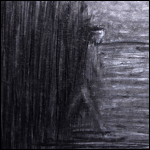 It is hard to know how to begin to cover all the drawing, its development and impact on the sculpture. From the series “Falkland Cow” and “Even Here in Our Exile”; through the wonderful “Bishop’s Demesne” series, chronicling - with a drawing made almost weekly through the year - the seasons on their farm in the Isle of Man during 1984; the “Crossing Open Ground” series, which includes pencil as well as charcoal workings and reworkings of an image strongly connected with a passage from the poet Rilke … “But because being here is much, and because all this that’s here, so fleeting, seems to require us and strangely concerns us. Us the most fleeting of all. Just once, everything, only for once. Once and no more. And we too, once. And never again …”; the “Bacchus and Ariadne” series, and many others; to the widely varied series of the last 20 years, including a number of large drawings made from photographs and post card reproductions, in which DG was attempting to make two dimensional images which might impart the kind of presence a sculptural form can possess; the “Annunciation” series; a series called “Openings”; and more recently a number of cogent non-figurative works in charcoal – dense, dark drawings: formlessness, with slits of light, hints of emergent form evolving, elusive.
It is hard to know how to begin to cover all the drawing, its development and impact on the sculpture. From the series “Falkland Cow” and “Even Here in Our Exile”; through the wonderful “Bishop’s Demesne” series, chronicling - with a drawing made almost weekly through the year - the seasons on their farm in the Isle of Man during 1984; the “Crossing Open Ground” series, which includes pencil as well as charcoal workings and reworkings of an image strongly connected with a passage from the poet Rilke … “But because being here is much, and because all this that’s here, so fleeting, seems to require us and strangely concerns us. Us the most fleeting of all. Just once, everything, only for once. Once and no more. And we too, once. And never again …”; the “Bacchus and Ariadne” series, and many others; to the widely varied series of the last 20 years, including a number of large drawings made from photographs and post card reproductions, in which DG was attempting to make two dimensional images which might impart the kind of presence a sculptural form can possess; the “Annunciation” series; a series called “Openings”; and more recently a number of cogent non-figurative works in charcoal – dense, dark drawings: formlessness, with slits of light, hints of emergent form evolving, elusive.Light and Dark
 Of the collection of drawings made from photographs and postcards, many have, as hoped, achieved a potent presence of their own. There is an impressive image made from a photograph of paramedics attending victims of a train crash, which has the quality of a Renaissance Lamentation of Christ, with its rendering of care and attention and tragedy; an astonishing and authoritative charcoal drawing from photographs in a biography of the philosopher Simone Weil, in which the handling of the medium and the meaning somehow serve to gather in the light and dark, the passion and the still centre in Weil’s own writing and life; a study from a picture of a group of children with a bonfire on some open land, which manages not to be illustrational, but through its presence convey a vivid and secretive world, and an atmosphere of desolation. Charcoal is the single most often used medium for all the drawings, and through it DG has been able to make extraordinary images of sometimes fierce power and beauty. This very partial listing gives but a hint of the reach and intensity of this aspect of DG’s endeavour, but is meant to suggest that drawing became a significant element in the overall body of his work.
Of the collection of drawings made from photographs and postcards, many have, as hoped, achieved a potent presence of their own. There is an impressive image made from a photograph of paramedics attending victims of a train crash, which has the quality of a Renaissance Lamentation of Christ, with its rendering of care and attention and tragedy; an astonishing and authoritative charcoal drawing from photographs in a biography of the philosopher Simone Weil, in which the handling of the medium and the meaning somehow serve to gather in the light and dark, the passion and the still centre in Weil’s own writing and life; a study from a picture of a group of children with a bonfire on some open land, which manages not to be illustrational, but through its presence convey a vivid and secretive world, and an atmosphere of desolation. Charcoal is the single most often used medium for all the drawings, and through it DG has been able to make extraordinary images of sometimes fierce power and beauty. This very partial listing gives but a hint of the reach and intensity of this aspect of DG’s endeavour, but is meant to suggest that drawing became a significant element in the overall body of his work.From the mid-80s, and at a time when he had been looking more closely and admiringly at the relief sculpture in the British Museum, DG began to see that relief work could be a discipline which, for him, might provide a bridge between free-standing sculpture and drawing, bringing with it its own particular language and conditions. The first major relief, “7 Days on the Ayres”, and those which followed enabled an exploration of the new possibilities of relief. While many have a narrative or pictorial quality, one or two, for example, ”The Bundle”, achieve a more ambiguous and subtle physicality. Later in the decade, during 1986-87, this experience of relief carving was invaluable when working on the commissioned panels surrounding the new Manx Museum Extension in Douglas.
At the same time, DG was also making woodcuts. This too went on throughout the period and until the last decade, more intensively so when he was without a large workshop, during the years in Lancaster in the 1990s, when larger sculptures could not readily be carved. There have been periods when a particular image, such as Titian’s “Bacchus and Ariadne”, have become a preoccupation which has then been developed in drawings, monotypes, woodcuts and reliefs. Some of the woodcuts, as with some of the reliefs, were closely allied to series of drawings. There are “Crossing Open Ground” woodcuts, as there is a “Falkland Cow” relief. One series of drawings led to a large, powerful woodcut - “One Story About How It Is”. This image, printed starkly in black ink on white paper, and arrived at through removal of much of the surface of the wood block, so as to leave only the outlines of the figures and hints of a space, is a composition comprising three ‘scenes’ – a figure standing at the back of the ground, his right foot on the surface in front of him, elbow resting on knee, banner held steadfastly in the other hand, recalling Pierro della Francesca’s “The Resurrection”; in front of this figure three others – a man, a woman, a child – depicted in simplified outline, broken, helpless, the crouching man pierced in several places by the horizontal and vertical lines which define the space, evoking the horror of Picasso’s “Guernica”; and in the right hand third of this large surface, a white figure against a black opening, seeming to be leaping either from a dark place onto a ladder – running away, perhaps – or, sometimes, appearing to be entering into the midst of the horror being witnessed. The irony is that it is hard to tell a story about what is happening here – while there is a visual coherence to the whole, the picture indicates incoherence, terror, sorrow, and it is not clear whether even the steadfast attention of the still figure at the back can touch the disintegration around him.
Where the Question Arises
 There are a number of sculptures, dating from the mid 80s up to the present, which are related in feel and form and which could be seen as part of a series going under the title “Oracle”, though all have had previous lives, with other titles. The earliest of the sculptures referred to is a piece in lignum (once exhibited at a show in the House of William Blake in 1995 called The Genitals are Beauty) of a finely carved lingam and yoni – which Hindus regard as standing for the ultimate unity of male and female qualities, and representing the totality of creation – with a small egg shaped form set between them. This piece has been called “Holy Family”, but is now “Oracle”. Traditionally, oracles as channels between the divine and human worlds, the transcendent and material, have been associated with the female – as source or medium. The tradition usually assumes a supplication and a response in the form of prophesy or revelation. In this, as in the other sculptures, however, it is not so clear cut as to where the question arises, the response emerges. A much later piece in this vein, from 2000, is “Hunter Gatherer,”a tall ziz-zag form, overlayed with beaten copper, standing on a base facing a large ball, hollowed at the top to form a bowl. In these two, as in all the sculptures which could be grouped into this series, there is a sense of the two forms being in the presence, each of the other, asking, listening, witnessing. It is this sense – of being in the presence of – which characterises much of DG’s work. Sculpture as physical presence, as waking us up to our response to being in the world.
There are a number of sculptures, dating from the mid 80s up to the present, which are related in feel and form and which could be seen as part of a series going under the title “Oracle”, though all have had previous lives, with other titles. The earliest of the sculptures referred to is a piece in lignum (once exhibited at a show in the House of William Blake in 1995 called The Genitals are Beauty) of a finely carved lingam and yoni – which Hindus regard as standing for the ultimate unity of male and female qualities, and representing the totality of creation – with a small egg shaped form set between them. This piece has been called “Holy Family”, but is now “Oracle”. Traditionally, oracles as channels between the divine and human worlds, the transcendent and material, have been associated with the female – as source or medium. The tradition usually assumes a supplication and a response in the form of prophesy or revelation. In this, as in the other sculptures, however, it is not so clear cut as to where the question arises, the response emerges. A much later piece in this vein, from 2000, is “Hunter Gatherer,”a tall ziz-zag form, overlayed with beaten copper, standing on a base facing a large ball, hollowed at the top to form a bowl. In these two, as in all the sculptures which could be grouped into this series, there is a sense of the two forms being in the presence, each of the other, asking, listening, witnessing. It is this sense – of being in the presence of – which characterises much of DG’s work. Sculpture as physical presence, as waking us up to our response to being in the world.During the years living in the Lleyn, many of the larger sculptures created have been made from pieces of lignum vitae DG had owned for many years. Some are single forms, some two or more forms combined. Lignum is an exceptional material, its dense and resinous wood thought to have protective and therapeutic properties in its native countries of origin. It is difficult to carve and highly polishable. It has a curiously aloof quality for a wood, and yet has been transformed in some of these carvings into timeless but humane pieces about being and relationship. One of these pieces is made up of two ‘abstract’ forms, carved from the same piece of wood and worked and subtly placed so that the relation between them becomes as significant as the forms themselves. The tensions here are palpable: between closeness and distance, inside and outside, solidity and space, relationship and separateness. It is hard to get caught up in a story about ‘what it’s about’ with a piece like this – it has to impress you physically. Some of these pieces could be included within the “Oracle” series already mentioned. Others are single forms or combinations which, in their different ways, are an elegant and less obviously figurative distillation of DG’s perennial concerns. The lignum, as a material, has an inevitable gravity and weight which brings its own special qualities to these sculptures.
Culmination - Something Quieter
 Alongside these larger lignum pieces, the years since 2001 have seen the emergence of a unique composite piece which has come to be called “What Is The Case”. It is made up of individual small sculptures, mostly made of balsa wood, each one housed in a clear Perspex box. There are over 100 pieces, so far, and when they have been exhibited – as they have been in Liverpool in 2008 during its time as European Capital of Culture, and in Lancaster University’s Peter Scott Gallery in 2009 - they have been arranged in groups of 10 or 12 on rectangular slate bases. The contrast of balsa with the lignum vitae is notable. It is a soft and vulnerable material, although, in its own way, also difficult to carve. Its vulnerability created the need for the boxes, for protection, but the boxes themselves then became a visual element in the whole piece, both framing the individual forms, as well as helping to integrate the separate components into a single piece of work.
Alongside these larger lignum pieces, the years since 2001 have seen the emergence of a unique composite piece which has come to be called “What Is The Case”. It is made up of individual small sculptures, mostly made of balsa wood, each one housed in a clear Perspex box. There are over 100 pieces, so far, and when they have been exhibited – as they have been in Liverpool in 2008 during its time as European Capital of Culture, and in Lancaster University’s Peter Scott Gallery in 2009 - they have been arranged in groups of 10 or 12 on rectangular slate bases. The contrast of balsa with the lignum vitae is notable. It is a soft and vulnerable material, although, in its own way, also difficult to carve. Its vulnerability created the need for the boxes, for protection, but the boxes themselves then became a visual element in the whole piece, both framing the individual forms, as well as helping to integrate the separate components into a single piece of work.This remarkable work could be seen as the culmination of a lifetime spent seeking a visual language to speak of the difficulty and intractability and mystery of being alive. Amongst the individual pieces will be found again some of the recurring forms – the ladders, the balls of wood and glass and metal – as well as new ways of representing existence, life – with chairs and boats, niches or rooms cut into the balsa block, flags and aerials. DG has written that the scale of these pieces could be seen as a response to the increase in scale of much sculpture since the 1960s. He suggests it might come out of a feeling “that something quieter and closer and less certain of itself could be said,” and that, perhaps, “the individual components are an interrogation of what is the case – as both a statement and a question.”
There are responses to other artists – Brancusi and Matisse, Turner and Serra; sometimes quite disquieting uses of scale as when a rectangular block of balsa is shallowly hollowed on top and, on closer inspection, the base of the hollow is covered in the small blackened forms of human bodies or when the crowd of tiny flat pin figures gather to enter the funnelled tunnel many times their height; physically compelling representations of time passing, of high tension, of the ephemeral and the durable, of our variousness and our emergence all from the same order and root. There is colour and burnt wood, tragedy and delight, life and death, all here. It has been a sustained and serious undertaking, free of pretension or obscurantism, and it is a work that will never be finished. These pieces need to be stood in front of quietly, looked at closely, and returned to again.
Work for all Times
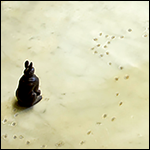 As a whole, this body of work displays many of the virtues of a Modernist sensibility. Its sustained questioning: “Is this what I see?”, as distinct from “This is what I see” – Cezanne’s original perception; its opening of a conversation with the onlooker; its remaining attentive to the questions raised, even as it makes a proposal – all the while concerned with the stuff and force of life, the press and void of death. And within that modernist sensibility is contained a strong current of a peculiarly English mysticism. The sense of the myriad complexity and diversity of the cosmos emerging from a unity of order beyond our knowing, which can only be pointed to through our saying, or better, showing, which flows through William Blake and Samuel Palmer, and forward in time through a number of writers and artists of the last 200 years. David Gilbert’s work, the sculptures and reliefs, the drawings and prints all point beyond themselves to a world in which they are but a speck, a grain of sand. As writer John Berger responded, after seeing a photograph of “In The Presence Of (Mountain Hares)”:
As a whole, this body of work displays many of the virtues of a Modernist sensibility. Its sustained questioning: “Is this what I see?”, as distinct from “This is what I see” – Cezanne’s original perception; its opening of a conversation with the onlooker; its remaining attentive to the questions raised, even as it makes a proposal – all the while concerned with the stuff and force of life, the press and void of death. And within that modernist sensibility is contained a strong current of a peculiarly English mysticism. The sense of the myriad complexity and diversity of the cosmos emerging from a unity of order beyond our knowing, which can only be pointed to through our saying, or better, showing, which flows through William Blake and Samuel Palmer, and forward in time through a number of writers and artists of the last 200 years. David Gilbert’s work, the sculptures and reliefs, the drawings and prints all point beyond themselves to a world in which they are but a speck, a grain of sand. As writer John Berger responded, after seeing a photograph of “In The Presence Of (Mountain Hares)”:
“It comes out of a loam which is absolutely genuine, nothing synthetic about it. And in that loam there are the smells and warmth of time immemorial”
Crossing Open Ground
At Bury Art Museum & Sculpture Centre 5th November 2022– 18th February 2023
A short film about this exhibition is available here on the video page.
This is a unique chance to see the body of work by sculptor/artist David Gilbert who rarely exhibited after the 60's being reluctant to engage with the commercial art world.
Nicholas Moseley described his sculptures as 'about birth, love, death; about the unmanageability of human life but also about its miracles; about the efforts to confront pain in order to know what to do about it.'
The exhibition features sculptures in wood, as well as some drawings.
Over the last 20 years of his life he had exhibitions at Peter Scott Gallery at Lancaster University, the Manx Art Gallery and Museum, and at a venue in Liverpool during the City of Culture event. At these exhibitions his work was viewed by the then Director of Tate Liverpool, and by the North West Arts Council Director Aileen McEvoy. They both commented that this was work that was very important in the history of British sculpture, and of his last work "What Is The Case?"although consisting of over 100 small sculptures, is monumental in meaning.
Born in Uxbridge 1928 and died in North Wales 2016. After reading English at Cambridge he lived briefly in Cornwall, London and Sweden. He then lived with his by then large family on Arran, in the Cotswolds, the Isle of Man, Lancaster and then for the final years of his life he moved to the northwest of Wales on the Lleyn Peninsula, working right up until the end of his life.
Any enquiries about the exhibition can be made to Bury Art Museum & Sculpture Centre or to the Trustees via the contact page on this website.